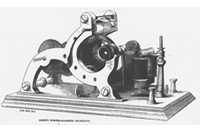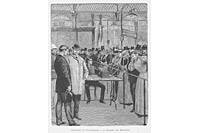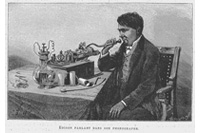Telegraph and Telephone
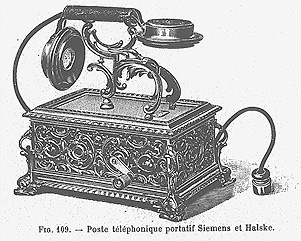 This is an image of a telephone exhibited at the Paris International Exposition of 1900. The 19th century witnessed many inventions in the telegraph and telephone field, realizing dramatic improvements in means of communication.
This is an image of a telephone exhibited at the Paris International Exposition of 1900. The 19th century witnessed many inventions in the telegraph and telephone field, realizing dramatic improvements in means of communication.
Telegraph
1From the 18th century, experimental telegraphs were made with the use of the properties of electricity. Such telegraphs included a spark type, an electrolytic type, and a magnetic needle type, although they were not put into a practical use. Practical use of what is called a "telegraph" employing the use of electricity began following the invention of the Voltaic battery by A. Volta of Italy. This led to the development of the wire telegraph and the wireless telegraph.
In 1825, W. Sturgeon of England developed a high-performance electromagnet. In 1831, using this electromagnet, the American J. Henry made a prototype of a telegraph. In 1837, in England, W. F. Cooke and C. Wheatstone obtained a patent for a five-needle-electromagnetic telegraph (which used five needles to point to a letter of the alphabet, depending on the angles of the needles), and conducted an experiment of communicating at a distance of 1.5 km. This was favored by the Great Western Railway, followed by its practical use. A line was erected from London Paddington to West Drayton, a distance of 21 km. This system was further improved with a two-needle version and a single-needle version. Around 1852, in the United Kingdom, a telegraph line with a total distance of 6,500 km was completed.
Meanwhile, in 1837 in the United States, S. F. B. Morse developed an electromagnetic telegraph. This was a telegraph that enabled communication through the conversion of letters and numbers into dots and dashes. Called "Morse Code," the telegraph came into a wide use across the world. Morse tried to sell his telegraph to the U.S. government, but in vain. He raised funds on his own and established the Magnetic Telegraph Company. When H. Sibley, a businessman, founded the Western Union Company in 1856, Morse was invited to join the company. Subsequently, the Western Union Company grew to be large enough to deal with approximately 90% of the telegraphs in the United States.
Telephone
Today's telephone system, in which electric current is used to transmit the human voice, is derived from a principle discovered by C. G. Page of the United States in 1837. Based on this principle, in 1854, the Frenchman C. Bourseul revealed his concept of the use of vibrations generated on flexible diaphragms by the voice. Moreover, based on this concept, in 1861, J. P. Reis of Germany conducted an experiment (in which voice was projected onto a thin sausage skin to produce vibrations, and the vibrations were converted into changes in electric current), taking a closer step toward the realization of the telephone.
The invention of a practical telephone was achieved in March 1876 by the American A. G. Bell. Featuring a diaphragm and a bar magnet in a coil of insulated wire, his telephone had a mechanism in which changes in electric current were generated according to sound wave vibration, and the generated electric current change was transmitted to convey the voice. Regarding this invention, an event occurred that still holds a special place in the history of the telephone. On February 14, 1876, the day that Bell filed his patent application for the invention, a similar application was also filed by E. Gray, only two hours after Bell's. Bell exhibited his telephone at the Philadelphia International Exposition of 1876, giving a telephone demonstration.
Phonograph
T. A. Edison, touted as the King of Inventors, promoted his research on telegraphs and telephones. One such research result was a phonograph invented in 1878. This machine recorded and replayed sound, with grooves cut with a needle onto a sheet of tin foil wrapped around a cylinder. The phonograph was the centerpiece exhibit at the fourth Paris International Exposition of 1889, attracting the second largest number of visitors after the Eiffel Tower.
Telegraph (17 images)
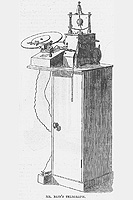 |
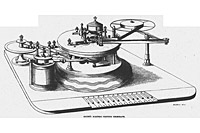 |
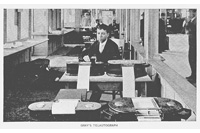 |
| Telegraph Invented by Alexander Bain | Electromagnetic Telegraph | Gray's Facsimile Instrument (Teleautograph) |
Telephone (7 images)
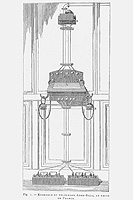 |
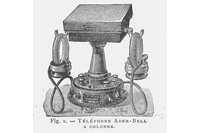 |
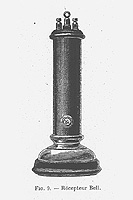 |
| Telephone Exhibited by Clément Agnès Ader | Column-type Telephone for General Use Exhibited by Clément Agnès Ader | Bell's Telephone (Receiver) |
- References:
Baldwin, Neil; Tsubaki Masaharu (tr).: Ejison: 20 seiki o hatumei shita otoko (Mita shuppankai, 1997) <GK428-G2>
Hashizume, Shinya (supervise).: Bankoku bikkuri hakurankai: Banpaku o 100 bai tanoshimu hon (Daiwa shobo, 2005) <D7-H48>
Onizuka, Shiro.: Tsushin no rekishi: Rika denwa no jikkenteki kosatsu (Tokyo tosho shuppankai, 2007) <ND511-H61>
Tamura, Norio.: Media jiten (KDD kurieitibu, 1996) <DK311-G4>
Yamakawa, Masamitsu.: Zusetsu ejison daihyakka (Omu sha, 1997) <GK428-G3>


